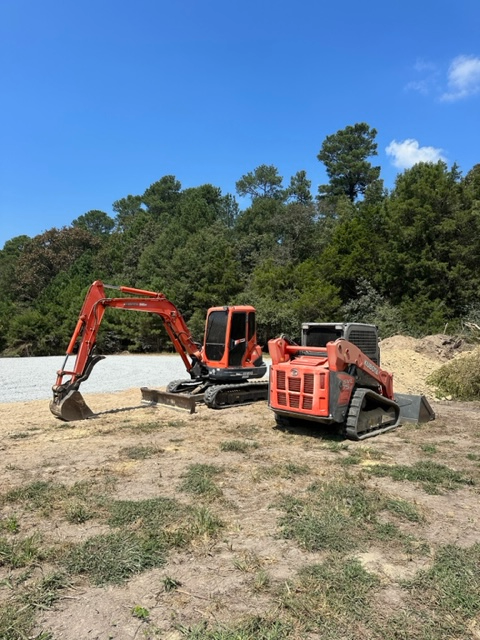Land clearing in North Carolina means working with steep slopes, dense clay soil, and quick-growing vegetation that can easily undo your progress if handled the wrong way. Before you start any project that requires land clearing, you need to learn how local conditions affect your project so you can protect your property and avoid costly mistakes.
In this blog post, you’ll learn what makes clearing land in North Carolina so challenging and how to avoid the most common mistakes.
What Makes Land Clearing Difficult in North Carolina
Land clearing is the process of removing trees, brush, stumps, and rocks to prepare property for development or farming. The process follows these general steps:
- Assessing the property and marking boundaries
- Identifying trees and vegetation to remove or preserve
- Cutting and removing unwanted trees and brush
- Grinding stumps and clearing debris
- Grading soil for proper drainage
- Inspecting the finished site for safety and stability
However, in North Carolina, land clearing gets more complicated than that.
The local terrain shifts from flat coastal plains to steep mountain slopes. Heavy clay soil in many regions traps water and causes drainage problems. Coastal areas include wetlands that often need special permits, while the rocky mountain ground makes grading slow and risky.
Top Mistakes in Land Clearing in North Carolina
North Carolina has some of the most beautiful land in the country, but as you’ve just learned, taming it takes specific knowledge and equipment. Many property owners make the same costly mistakes when trying to clear their property. The sections below explain the most common ones.
Over-Clearing Vegetation
One of the most crucial errors to avoid in land clearing projects is removing too much vegetation. Cutting down trees and brush too aggressively destroys the root systems that keep soil firm and absorb water.
Once those roots are gone, heavy rain washes away topsoil, cuts deep channels in the ground, and weakens nearby structures. In areas with dense clay, like North Carolina, over-clearing also traps water on the surface and leads to erosion and unstable foundations.
Using the Wrong Equipment
Heavy machinery on soft soil crushes the surface and blocks drainage. On steep or rocky ground, the same equipment can loosen slopes or cause the soil to collapse. Each type of terrain in North Carolina needs its own approach. The wrong setup often leaves deep ruts, uneven grading, and compacted soil that traps water instead of letting it flow naturally.
Poor Drainage and Grading Plans
Starting work without a drainage plan leaves water with no clear path. After a heavy rain, low areas flood, and soft ground erodes.
In North Carolina’s uneven terrain, water naturally collects in valleys and slopes, which increases runoff and soil loss. Poor grading weakens the ground and makes building on it risky and expensive.
Removing Valuable Trees Without Planning First
Cutting down trees without first evaluating their importance has the potential to permanently damage your property. Mature trees often hold soil in place, block wind, and add natural shade.
When they’re cleared carelessly, erosion speeds up, and property value drops. Many landowners regret losing these trees once they realize how much protection they provided.
Best Practices To Prevent Land Clearing Errors
Professional land clearing companies like JDI Land Management avoid these mistakes through planning and experience.
Before work begins, they evaluate the site, study the soil, and check local regulations that affect clearing and grading. Their crews understand how to handle North Carolina’s terrain safely and organize each step to keep the land stable.
Best practices to prevent land clearing errors include:
- Installing erosion control measures before clearing begins
- Securing all required permits and local approvals
- Clearing vegetation selectively instead of removing everything
- Grading slopes gradually to guide water flow safely
- Inspecting and maintaining equipment before each phase
Professional tools such as forestry mulchers, compact track loaders, and excavators allow precise clearing without damaging the soil. Skilled arborists know how to protect root systems and minimize debris buildup.
Safety also defines professional work. Crews wear protective gear, follow communication protocols, and mark all work zones clearly.
These standards separate reliable companies from amateurs. Professionals follow methods that protect the soil, preserve valuable trees, and prepare the land for construction or agriculture.
Avoid Common Land Clearing Mistakes With Professional Solutions From JDI Land Management
JDI Land Management provides professional land clearing services across North Carolina. The team understands local terrain, vegetation, and environmental laws. Each project follows proven land clearing pitfalls and solutions that keep the property stable and compliant.
Each crew member brings years of experience with North Carolina’s terrain and weather, which helps them complete every phase of clearing, grading, and debris removal safely and efficiently.
Call (704) 288-0511 or complete our contact form to schedule professional land clearing with JDI Land Management and avoid the common errors that cause erosion, delays, and unnecessary repair costs.

